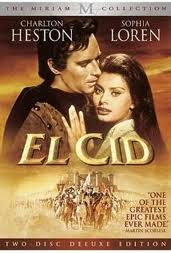Castles on the Rhine aren't there accidentally. The Rhine
is a big river, and ever since boats were invented, this river has been
Europe's most valuable means of commerce.
For millennial bends in the river provided ideal spots for bullies to
build castles overlooking bends and tributaries to extract fees from merchants
needing to go upstream and down.
Toledo was born with that idea in mind; but Spanish
rivers are fewer and don't command much commerce. Still, Toledo is imposing, looming over the
plain to the north like a sentinel. A
military couldn't do much about Spain without controlling this city built on a
huge rock. It has the fewest level
streets of any European city.
 I didn't have an urge to dominate the Castile region, but
I did want to spend time in a city that
has a cathedral that resolved its unfinished dome problem by having angels
flying around the hole. I wanted also to
see El Greco's home. He couldn't marry the love of his life because, since she
was a Jew, if he married her, his son would be ostracized. (You figure that one
out).
I didn't have an urge to dominate the Castile region, but
I did want to spend time in a city that
has a cathedral that resolved its unfinished dome problem by having angels
flying around the hole. I wanted also to
see El Greco's home. He couldn't marry the love of his life because, since she
was a Jew, if he married her, his son would be ostracized. (You figure that one
out).
Actually, I went to Toledo because I'd been told that it
is the number one place in the world to see how Damascene is made. The number one shop is just north of the monster
rock that is the city.
 Damascene
refers to Damascus, the probable city of the technique's origin. The decorated steel figures appeared when
Turkey, Syria, and the Caliphs of the Tigris/Euphrates were beating up on
everyone in general and had established a lock on southern Spain. The world's
best steel then was Persian made. The Caliphates tossed in stuff like Algebra,
medicine, cotton, and were pretty good at building palaces and mosques. They
became incredibly good at decorating things, including armor and plaster. Decorating
their horse trappings and armor with delicate designs of gold on steel was the
ultimate in their art.
Damascene
refers to Damascus, the probable city of the technique's origin. The decorated steel figures appeared when
Turkey, Syria, and the Caliphs of the Tigris/Euphrates were beating up on
everyone in general and had established a lock on southern Spain. The world's
best steel then was Persian made. The Caliphates tossed in stuff like Algebra,
medicine, cotton, and were pretty good at building palaces and mosques. They
became incredibly good at decorating things, including armor and plaster. Decorating
their horse trappings and armor with delicate designs of gold on steel was the
ultimate in their art.
When Isabella and Fernando rooted out the last of the
Moors (who were mostly north African), some Spaniards had mastered this mostly secret
art of welding steel to gold.
If it had been the high season, I might have been out of
luck to learn much; but as soon as I showed interest in the torches, the
supervisor of the shop I examined gave me a tour that lasted all afternoon. The
lead welder explained why the torches
were of varying sizes, how they fused the steel and gold, and how the black is
applied. I was allowed to meander everywhere, which was about the size of two
tennis courts. As you might expect, not the tiniest amount of gold ever
hit the floor, or disappeared. A little steel
might be burned away, but very little of that either.
Once I commented on an interesting steel design high on a
wall. The foreman instantly went ballistic.
"EL CID!!!" he yelled.
When he eventually cooled off enough to speak at a pace I
could track, he led me to understand that a movie company (American) had
produced the film "El Cid" on location near Toledo and contracted for
all sorts of welding and weaponry and other props useful in the film. But they
had not been very forthcoming with cash when due.
"Hollywood!" my tutor finally grumbled, drawing
a finger across his throat. When he eventually stopped sputtering, he murmured something
that was probably just as well I couldn't translate.
At last he smiled. He pointed toward a large sign outside
the shop that told visitors there was a forty percent discount on Damascene
that day.
“For the buses,” he said. “Means nothing." Then he
added, "Don't buy when the buses are here. When there is just you, then
buy. Not forty percent... Eighty percent.”
I still have the bolo I'd watched him make from a blob of
gold and a piece of steel. AND I got it
at eighty per cent off some price he invented because "the bus
people" were not shopping.






























.jpg)


















